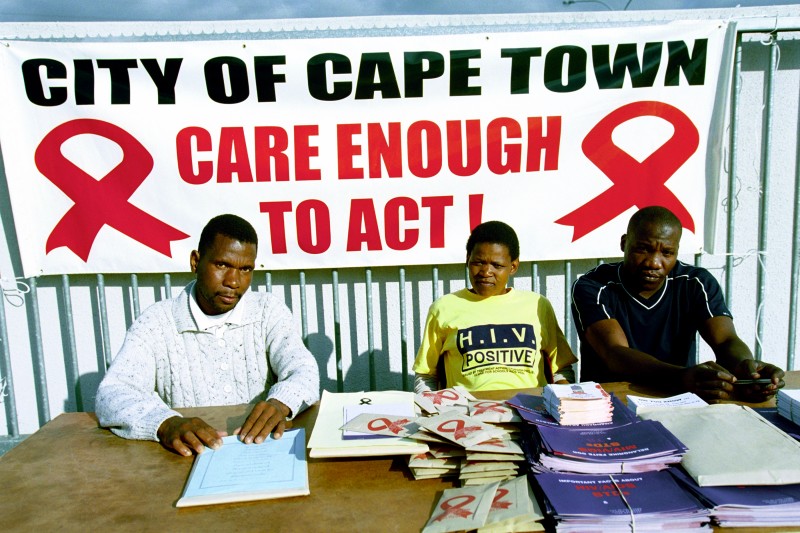Mass media interventions, such as leaflets, improve uptake of HIV testing (between 6% and 16%).

Photo Credit: Trevor Sampson
![]() Place of Residence
Place of Residence ![]() Gender
Gender
Why are mass media interventions important for increasing voluntary HIV counseling and testing?
- Mass media interventions refer to the communication of information to many people at the same time using television, radio, the Internet, newspapers, books, posters, and billboards. Some of media are affordable and accessible in both high and low income settings. Many of the barriers to HIV testing include lack of knowledge about HIV, lack of knowledge about the benefits of testing, and stigma. Mass media campaigns can help address these issues.
Do mass media interventions work to increase voluntary HIV counseling and testing?
- Voluntary HIV testing and counseling (VCT) allows a person to receive counseling to make an informed decision about whether to undergo HIV testing. Counseling is usually provided after testing as well. Mass media interventions have immediate effects on increasing voluntary VCT.
Equity: do they work in the disadvantaged?
- There is no evidence to suggest the mass media campaigns would not be effective in increasing VCT rates among the disadvantaged provided the testing is accessible to everyone.
Intervention Delivery
- The mass media interventions varied widely and included two types of leaflets (one provided information about all blood tests and one HIV information) provided with either minimal discussion or comprehensive discussion; videos which focused on desirable and undesirable outcomes; multimedia campaigns; and group education.
- The interventions focused on watching, reading, or hearing information and were not facilitator based
Population and Setting
- Studies were conducted in high-income countries: Australia, Canada, Israel, the United Kingdom, and the United States.
- Two randomized controlled trials, three non-randomized controlled trials and nine interrupted time series analyses (ITS) were included in the final analysis. Seven of these studies were done in United Kingdom, three in the United States of America, two in Australia, and one each in Canada and Israel.
- No studies were found from developing countries or countries with generalized HIV epidemics.
- These studies targeted the general public, pregnant mothers, gay and bisexual men, blood transfusion recipients, and low-income ethnic minority women.
Summary of Findings [SOF] Table: Mass media interventions for promoting HIV testing
Patient or population: Pregnant women attending the main maternity hospital
Settings: Edinburgh, UK
Intervention: Leaflets
Comparison: No intervention
| Outcomes | Anticipated absolute effects per year | Rate ratio | No of Participants | Quality of the evidence | ||
| Risk without mass media (Control) | Risk with mass media (95% CI) | |||||
| Uptake of HIV testing (RCT) | 5 people per 100 get tested | 29 more get tested per 100 (from 21.1 to 39.5 more) | 6.29 (4.84-8.19) | 3024 (1) | Moderate1 | |
| Uptake of HIV testing (CCT) | 5 people per 100 get tested | 43 more get tested per 100 (from 36.3 to 49.1 more) | 15.96 (12.33-20.66) | 1918 (1) | Moderate1 | |
| Adverse events: in the RCT, 14% of the participants both the delayed and early treatment arms had severe adverse events such as infections, gastrointestinal disorders, metabolic and nutritional disorders and psychiatric and nervous system disorders. | ||||||
| About quality of evidence (GRADE) | ||||||
1. Wide confidence interval.
2. Wide confidence interval.
Relevance of the review for disadvantaged communities
Mass media interventions, such as leaflets, improve uptake of HIV testing (between 6% and 16%).
There is no evidence to suggest the mass media campaigns would not be effective in increasing VCT rates among the disadvantaged provided the testing is accessible to everyone
| Findings | Interpretation |
| Equity – Which of the PROGRESS groups examined |
|
| All included studies were conducted in non-epidemic, high-income countries. | Mass media programs provided short term increases in VCT in high-income countries. |
| One study examined the effectiveness of a mass media campaign on pregnant women. | There was not enough evidence to indicate whether different messages and delivery mediums affect the effectiveness of mass media programs for pregnant women. |
| One study examined the effectiveness of a mass media campaign on low income, ethnic minority women | There was not enough evidence to indicate whether different messages and delivery mediums affect effectiveness of mass media programs depending on gender, income, race, ethnicity, or culture. |
| One study examined the effectiveness of a mass media campaign on gay and bisexual men. | There was not enough evidence to indicate whether different messages and delivery mediums affect effectiveness of mass media programs depending on sexual orientation. |
| Equity Applicability |
|
| Most studies examined the effectiveness of multimedia interventions, including television, radio, newspapers, leaflets, and posters. One study used videos, one study used group education, and one study used leaflets with discussions. | All the studies found that mass media interventions increased VCT. These results are likely applicable in other high-income country settings. |
| All included studies were conducted in non-epidemic, high-income countries. | It is not clear whether the results of this study are applicable to countries with high incidence rates of HIV or low- and middle-income countries. |
| All included studies were conducted before 2004. | With newer testing technologies, such as rapid testing, the effectiveness of mass media campaigns may be different. |
| Cost-equity |
|
| The authors were not able to assess the cost effectiveness of mass media interventions to promote HIV testing. Additional research should examine the cost-effectiveness of mass media programs. | Policymakers considering implementing a mass media campaign to promote VCT must weigh the costs and benefits. The production of mass media materials plus the additional resources required to collect and test the samples and provide appropriate counseling and treatment need to be balanced by the benefits of diagnosis and early treatment. |
Comments on this summary? Please contact Jennifer Petkovic.
